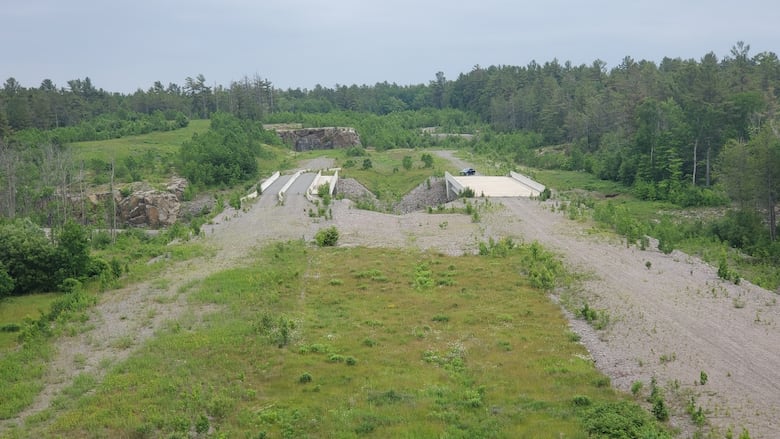Little action on Highway 69 expansion as new bridges sit unused
Ontario built 2 bridges over a future railway realignment, but now plants grow out of disused structures

Two brand-new highway bridges in the northeast remain unused, eight years after they were built for the future twinning of Highway 69.
The highway runs from Sudbury to near Nobel, Ont., where it turns into Highway 400. Some 68 kilometres of the route remain an undivided, two-lane highway.
During a previous expansion, construction crews built two bridges south of Grundy Lake Provincial park. Those will carry the future highway over a realignment of the CN Railway mainline. But since their completion in 2017, the bridges have yet to carry car traffic, and the railway has not been rerouted.
In the meantime, plants have started growing on the gravel highway right-of-way and on the bridges themselves. The unfinished rail bed also has plants growing out of it, and there are places where erosion has worn away parts of the surface.
Bridges in 'excellent condition'
In a statement, Ontario's Ministry of Transportation said the bridges do not require maintenance because they are not open to the public. However, a spokesperson for the ministry said the bridges were in excellent condition when inspected last year.
Plant growth can eventually harm the integrity of structures like bridges, said Scott Walbridge, chair of University of Waterloo's civil and environmental engineering department.
Walbridge said he couldn't speak to these bridges specifically, because he hadn't seen them in person. However, he said damages due to environmental exposure, like rusting and plant growth, tend to be a gradual processes that makes impacts over a long period of time.
"It would be something a bridge owner would ideally want to stay on top of, if the intention is to eventually use these structures, in order to avoid potentially larger long-term costs," he said.
Associate professor Rania Al-Hammoud, also from University of Waterloo, agreed the plant growth has likely had a minimal impact so far, but it's hard to tell without inspecting the structures first hand.
She said if plant roots reach the steel reinforcements, the steel can rust and grow up to 10 times in size. That puts pressure and strain on the concrete.
However, without any traffic on the bridges, Al-Hammoud said they are also subject to less fatigue stress, which could improve their lifespan.

The MTO spokesperson said the bridges would be waterproofed and paved before they open and the roadbeds would have their gravel replaced as necessary. The bridges are expected to have a lifespan of 75 years.
CBC News asked CN about the erosion and plant growth on its future rail bed, and why it hadn't yet shifted the mainline to the new alignment. A spokesperson declined to comment, saying all questions should be directed to the MTO.
Lack of clear timelines 'frustrating'
The New Democrat MPP for Sudbury, Jamie West, recently co-wrote a letter to the transport minister, alongside Nickel Belt MPP France Gelinas.
The letter expressed frustration over a lack of new action on Highway 69. West said they penned the letter after the premier's recent comment at a Thunder Bay press conference, that he was "all in" on highways in the north.
MTO continues to say that expanding Highway 69 is a priority project. However, West said the province remained vague on its timelines for twinning the highway.
"We need improvements across the north. But pretending [the premier] is talking about Highway 69 when he's 12, 13 hours away from Highway 69, you know, it's not really fair to get people's hopes up," said West.
Last year, the province announced it had struck a tentative agreement with Shawanaga First Nation on expanding the highway through its territory. Earlier this year, the chief of Henvey Inlet said he hoped to ratify a deal for his community by this summer.
According to 2021 statistics, Highway 69 carried more than 11,000 vehicles per day at its busiest section, near Estaire. Those numbers trend higher in the summer.

